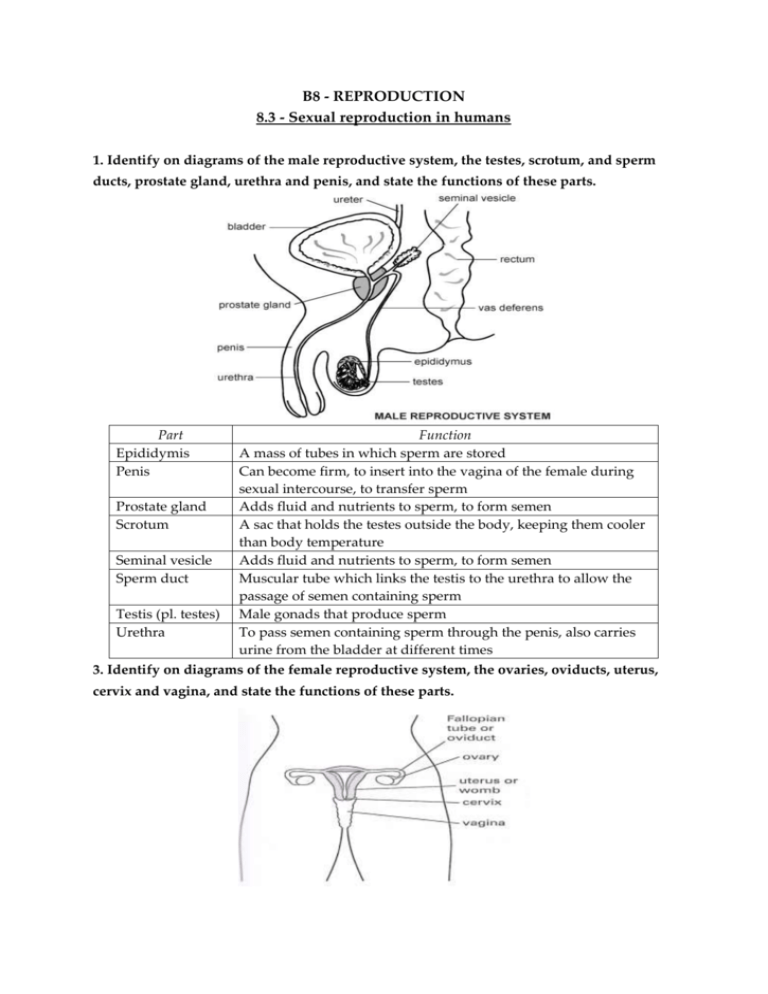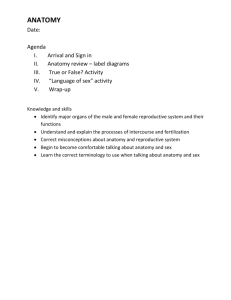B8.3 Revision Notes
advertisement

B8 - REPRODUCTION 8.3 - Sexual reproduction in humans 1. Identify on diagrams of the male reproductive system, the testes, scrotum, and sperm ducts, prostate gland, urethra and penis, and state the functions of these parts. Part Epididymis Penis Prostate gland Scrotum Seminal vesicle Sperm duct Testis (pl. testes) Urethra Function A mass of tubes in which sperm are stored Can become firm, to insert into the vagina of the female during sexual intercourse, to transfer sperm Adds fluid and nutrients to sperm, to form semen A sac that holds the testes outside the body, keeping them cooler than body temperature Adds fluid and nutrients to sperm, to form semen Muscular tube which links the testis to the urethra to allow the passage of semen containing sperm Male gonads that produce sperm To pass semen containing sperm through the penis, also carries urine from the bladder at different times 3. Identify on diagrams of the female reproductive system, the ovaries, oviducts, uterus, cervix and vagina, and state the functions of these parts. Part Cervix Funnel of oviduct Ovary Oviduct Function A ring of muscle that separates the vagina from the uterus Directs an ovum (egg) from the ovary into the oviduct Contains follicles in which ova (eggs) are produced Carries an ovum to the uterus, with propulsion provided by tiny cilia in the wall; also the site of fertilization Carries urine from the bladder Where the fetus develops Receives the male penis during sexual intercourse; sperm are deposited here Urethra Uterus Vagina 2. Compare male and female gametes in terms of size, numbers and mobility. Types of gamete Egg Sperm Structure 1. Is large in size 0.1mm because it has all cell components that is needed for the cell to grow and multiply; has yolk to nourish the embryo. 2. During ovulation, only one egg is released every month. 3. Ovum is immobile as the sperm moves towards it to fertilise it. 1. Size is very small 0.05mm. 2. During ejaculation millions of sperms are produced into the women’s vagina. 3. Sperms are highly mobile and can swim towards the oviduct with he help of its tail. 4. Describe the menstrual cycle in terms of changes in the uterus and ovaries. 5. Describe the fertilization in terms of the joining of the nuclei of male gamete (sperm) and the female gamete (egg). 1. During sexual intercourse, erect penis is inserted into vagina; 2. Semen is ejaculated into the neck of vagina; 3. Many sperms cluster around ovum but only one penetrates; 4. A fertilization membrane is secreted around the egg once one sperm enters; 5. The sperm nucleus fuses with egg nucleus to form zygote, this process is called fertilization. 6. Outline early development of the zygote simply in terms of the formation of a ball of cells that becomes implanted in the wall of the uterus. 7. Indicate the functions of the amniotic sac and amniotic fluid. Structure Amniotic sac Amniotic fluid Function A thin membrane, formed from cells of embryo, contains the amniotic fluid; It encloses the fetus and prevents entry of bacteria. Supports the fetus, protecting it from physical damage; It absorbs excretory materials (urine) released by the fetus. 8. Describe the function of the placenta and umbilical cord in relation to exchange of dissolved nutrients, gases and excretory products (no structural details are required). The placenta brings the blood supply of the fetus close to that of the mother, but prevents mixing; This is important because the fetus and mother may have different blood groups and any mixing can result in blood clotting; Also the mother’s blood pressure is higher compared to the fetus which might damage the fetal organs; Blood from fetus passes through the umbilical cord in the umbilical artery to the placenta. Substances that diffuse across the placenta are as follows: Type of substance Respiratory gases Soluble nutrients Disease-preventing substances Nitrogenous excretory substances Potentially harmful substances To fetus from mother Oxygen Amino acids, glucose, fatty acids, glycerol, vitamins, minerals, water Antibodies, antibiotics To mother from fetus Carbon dioxide Urea Alcohol, nicotine and other drugs, viruses, bacteria 9. Describe the advantages and disadvantages of breast-feeding compared with bottlefeeding using formula milk. Advantages of breast-feeding over bottle-feeding: There are antibodies present in the breast milk, giving the baby protection against infection; Foodstuffs are present in breast milk in the correct proportions; There are no additives and preservatives in breast milk; Breast feeding builds a bond between mother and baby; Breast milk does not require sterilization as there are no bacteria present that could cause intestinal disease; Breastfeeding triggers a reduction in the size of the mother’s uterus. Formula milk is much more expensive than breast milk, which is free. Advantages of bottle-feeding over breast-feeding: Someone else can feed the mother’s baby; This can also help the father to bond with the baby, if he is involved in feeding. 10. Describe the method of transmission of human immunodeficiency virus (HIV), and the ways in which HIV/AIDS can be prevented from spreading. HIV may result in AIDS Methods of transmission Unprotected sexual intercourse with an infected person Drug use involving sharing a needle used by an infected person Transfusions of unscreened blood Infected mother to fetus Feeding a baby with milk from an infected mother Use of unsterilized surgical instruments Ways of preventing its spread Use of condom for sexual intercourse Abstinence from sexual intercourse Screening of blood used for transfusions Use of sterilized needles for drug injections Feeding a baby with bottled milk when the mother has HIV Use of sterilized surgical instruments 11. Outline how HIV affects the immune system in a person with HIV/AIDS. HIV virus attacks some types of lymphocyte (white blood cells) in the bloodstream; Lymphocytes produce antibodies, which attack the antigens present on invading microbes; So HIV stops this happening - thus the person develops symptoms of AIDS; So they become vulnerable to infections (like pneumonia, tuberculosis and cancer); A person with AIDS usually dies of a collection of several illnesses.





